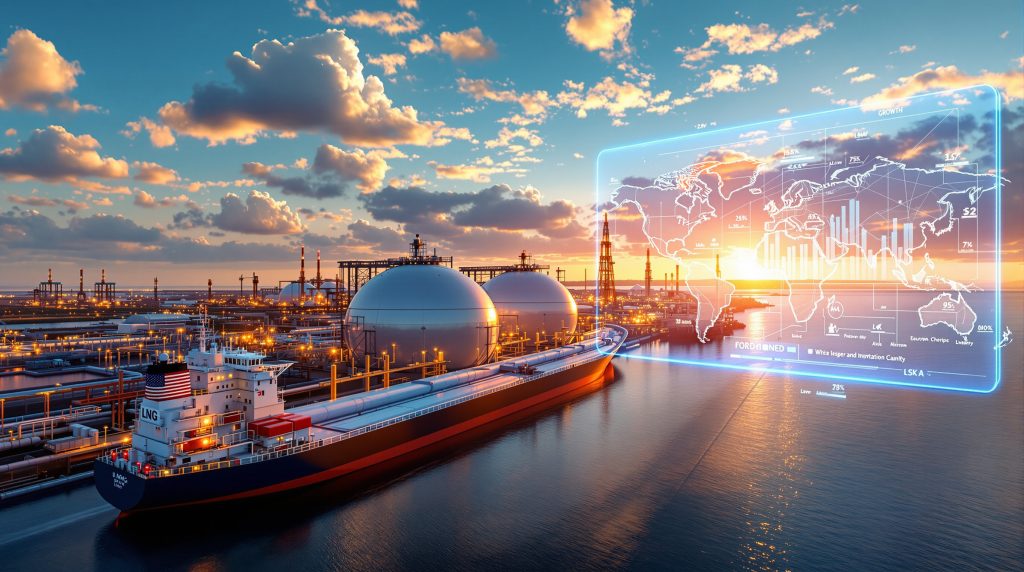Understanding America's Natural Gas Export Revolution
The United States has transformed into the world's leading natural gas exporter in less than two decades, fundamentally altering global energy dynamics. This remarkable shift from net importer to export powerhouse represents one of the most significant changes in international energy markets since the emergence of hydraulic fracturing technology. U.S. natural gas exports have become a cornerstone of America's energy strategy, influencing both domestic markets and international relationships.
Monthly export records continue to shatter previous benchmarks, with September 2025 reaching 9.4 million tons of liquefied natural gas (LNG) exports, surpassing August's 9.3 million tons. These consecutive monthly highs demonstrate the sustained momentum behind America's export capabilities and growing international demand for American natural gas.
Table: U.S. Natural Gas Export Performance (2020-2025)
| Year | Total Exports (Tcf) | LNG Exports (Tcf) | Pipeline Exports (Tcf) | Global Market Share |
|---|---|---|---|---|
| 2020 | 5.2 | 3.4 | 1.8 | 12% |
| 2021 | 6.1 | 4.2 | 1.9 | 15% |
| 2022 | 6.8 | 4.9 | 1.9 | 18% |
| 2023 | 7.3 | 5.4 | 1.9 | 21% |
| 2024 | 7.7 | 5.8 | 1.9 | 23% |
| 2025* | 8.1 | 6.2 | 1.9 | 25% |
*Projected figures
The infrastructure supporting this export boom has evolved rapidly, with new terminals and expanded facilities creating unprecedented capacity for international sales. Furthermore, this growth trajectory positions the United States as the dominant force in global LNG markets, influencing pricing mechanisms and supply security worldwide.
What's Driving America's Natural Gas Export Boom?
Infrastructure Expansion Creates New Opportunities
Massive investments in export infrastructure have laid the foundation for America's natural gas success story. Gulf Coast facilities have undergone significant expansions, with new terminals coming online and existing operations scaling up to meet growing international demand.
These infrastructure developments have enabled the country to achieve remarkable export volumes, with monthly records reflecting a 60% surge compared to early 2020 levels. The continued buildout of export capacity demonstrates the industry's confidence in sustained global demand and America's ability to compete in international markets.
Current export capacity stands at approximately 14 billion cubic feet per day as of July 2025, with industry analysts projecting potential expansion to 27 billion cubic feet per day. This dramatic scaling represents the physical manifestation of America's strategic positioning in global energy markets, particularly as US tariff dynamics continue to influence trade relationships.
Shale Production Fuels Export Growth
The abundance of domestic natural gas production from major shale formations provides the supply foundation for export operations. Key producing regions including the Permian, Marcellus, and Haynesville basins generate surplus volumes that make large-scale international sales economically viable.
Key Production Dynamics:
- Daily production capacity supports sustained export growth
- Associated gas from oil drilling contributes significant volumes
- Proven reserves ensure decades of export potential
- Regional production diversity reduces supply concentration risks
However, industry dynamics are shifting as mature shale basins experience similar trends to oil production areas. The depletion of sweet spots, the lowest-cost and highest-yield reservoir sections, creates upward pressure on production costs that will influence future pricing and export economics.
Price Dynamics and Production Economics
Natural gas pricing has experienced notable volatility, with October 2025 prices reaching $3.03 per mmBtu, representing a substantial increase from previous year levels. Industry executives indicate that sustainable production from less productive shale areas requires pricing around $5.00 per mmBtu, nearly doubling recent price levels.
This pricing dynamic creates tension between export growth and domestic affordability. Producers demonstrate sensitivity to price changes, reducing drilling activity when prices decline and increasing production when prices rise sufficiently to justify investment in costlier drilling areas.
How Do U.S. Natural Gas Exports Impact Global Markets?
Reshaping International Energy Security
American natural gas exports have fundamentally altered global energy security calculations, particularly for European markets seeking alternatives to traditional pipeline suppliers. This shift has created new trade relationships and reduced dependence on geographically concentrated supply sources.
The integration of U.S. supply into global markets has introduced greater flexibility and competition, benefiting importing countries through diversified supply options and more competitive pricing structures. Countries across multiple continents now view American LNG as a cornerstone of their long-term energy security strategies, especially given ongoing US-China trade tensions that affect global supply chains.
Price Discovery and Market Integration
U.S. natural gas exports have introduced Henry Hub pricing mechanisms to international markets traditionally dominated by oil-indexed contracts. This transformation has created more transparent and competitive pricing structures, giving buyers additional options for contract terms and pricing formulas.
Market analysts emphasise the fundamental tension between export growth and domestic price stability. Wood Mackenzie analyst Eugene Kim explains that "supporting LNG export expansion alongside domestic power demand growth necessitates higher prices, creating policy challenges for administrations seeking both energy dominance and affordable domestic energy."
International Precedents and Policy Lessons
Norway's experience provides a relevant case study for balancing export revenues with domestic affordability. When Norway increased gas and electricity exports to Europe several years ago, domestic energy costs rose significantly, prompting government intervention to limit export volumes and protect Norwegian consumers from excessive price increases.
This precedent illustrates the inherent tension between export-driven economic benefits and domestic energy affordability. Consequently, American policymakers must navigate this challenge as export capacity continues expanding.
Where Are U.S. Natural Gas Exports Headed?
Global Demand Projections Drive Expansion
International demand for natural gas continues growing, with Shell forecasting a 60% increase in global LNG demand by 2040. Tom Summers, head of Shell's LNG trading division, attributes this growth to expanding needs for power generation, heating, cooling, industrial applications, and transportation fuel across multiple regions.
These demand projections support continued investment in U.S. export infrastructure and production capacity. Additionally, the combination of growing global demand and America's competitive production costs creates favourable conditions for sustained export growth over the coming decades.
Regional Export Destinations
American natural gas reaches diverse international markets through both pipeline and LNG exports. Mexico remains the primary destination for pipeline exports, whilst LNG shipments serve customers across Europe, Asia-Pacific, Latin America, and other regions worldwide.
Major Export Destinations:
- European Union: Primary LNG destination driven by energy security concerns
- Asia-Pacific: Significant market for long-term supply contracts
- Latin America: Growing regional demand for cleaner energy sources
- Other markets: Emerging destinations across multiple continents
The geographic diversity of export markets reduces dependence on individual regions and provides flexibility for optimising sales based on seasonal demand patterns and pricing conditions.
What Are the Economic Implications of Export Growth?
Domestic Market Effects
The surge in U.S. natural gas exports creates complex economic dynamics within the United States, generating significant economic benefits whilst potentially increasing domestic energy costs. Export growth supports job creation across the energy value chain and generates substantial tax revenues for federal and state governments.
Recent analysis suggests that continued export expansion could increase domestic natural gas prices by 30% or more by 2050, potentially adding over $100 annually to household energy costs. This projection reflects the growing integration of U.S. natural gas markets with international pricing, where American consumers increasingly compete with global buyers for domestic production.
Economic Impact Overview:
- Job Creation: Direct and indirect employment across export infrastructure
- Tax Revenues: Federal and state income from export operations
- Investment Capital: Billions in infrastructure development
- Consumer Costs: Potential increases in domestic energy expenses
Industry Investment Requirements
Natural gas producers face increasing investment requirements to maintain production growth as drilling moves to less productive reservoir areas. Industry executives emphasise the need for stable, long-term pricing to justify continued investment whilst avoiding demand destruction from excessive price volatility.
The chief executive of Aeton Energy Management highlights the industry's preference for "stable commodity pricing that supports sustained investment without creating market disruption through extreme price fluctuations."
Demand Elasticity Considerations
Both oil and natural gas demonstrate relatively inelastic demand characteristics, meaning consumption patterns do not change proportionally with price increases. This market dynamic suggests that moderate price increases will not significantly reduce consumption, allowing producers to maintain revenue growth even as costs rise.
However, this inelasticity also means that consumers bear the burden of price increases without proportional consumption reductions. This creates political and social challenges for policymakers managing the balance between export growth and domestic affordability, particularly when considering tariff impacts on investments across the broader economy.
How Do Environmental Factors Influence Export Policy?
Climate Change Considerations
The expansion of natural gas exports raises important questions about long-term climate objectives and environmental impacts. Whilst natural gas burns cleaner than coal for power generation, increased production and export infrastructure contribute to overall greenhouse gas emissions throughout the supply chain.
Policymakers must balance the economic benefits of export growth against environmental commitments and international climate agreements. This balancing act influences regulatory approvals, infrastructure development timelines, and long-term strategic planning for the energy sector, especially as countries navigate energy transition challenges.
Regulatory Framework Evolution
The Department of Energy continues evaluating export applications against public interest criteria, considering multiple factors that extend beyond economic benefits. These evaluations incorporate environmental consequences, geopolitical advantages, infrastructure safety requirements, and impacts on domestic energy consumers.
Key Regulatory Considerations:
- Environmental Impact: Lifecycle greenhouse gas emissions assessment
- Economic Effects: Domestic consumer cost implications
- Energy Security: Geopolitical benefits of export relationships
- Infrastructure Safety: Terminal and pipeline safety standards
The regulatory framework continues evolving as policymakers gain experience with the implications of large-scale natural gas exports and their effects on domestic and international energy markets.
What Challenges Face U.S. Natural Gas Exports?
Basin Maturation and Production Costs
American shale gas basins are experiencing maturation trends similar to those observed in oil production areas. The depletion of sweet spots, the most productive and cost-effective drilling locations, creates upward pressure on production costs and long-term pricing.
These geological realities mean that maintaining production growth requires accessing less productive reservoir areas with higher drilling and completion costs. Industry participants emphasise that gas drillers need prices of $5.00 per mmBtu to justify investment in these costlier drilling areas, representing a significant increase from current levels.
Market Competition and Pricing Pressures
As global LNG supply increases from multiple producing countries, U.S. exporters face intensifying competition from Australia, Qatar, Russia (despite sanctions), and emerging producers worldwide. This competition pressures profit margins and requires continuous efficiency improvements to maintain market position.
Competitive Challenges:
- International Suppliers: Competition from established LNG exporters
- Production Costs: Rising costs from basin maturation
- Price Sensitivity: Producer responsiveness to market conditions
- Supply Tightness: Balancing production with export demand
Furthermore, OPEC production effects on oil markets indirectly influence natural gas dynamics through associated gas production from oil wells.
Infrastructure and Investment Bottlenecks
Despite rapid infrastructure development, export capacity still lags behind potential demand in many markets. Pipeline constraints, terminal capacity limitations, and regulatory approval delays create bottlenecks that limit export potential and increase project development timelines.
The industry requires sustained capital investment to overcome these constraints, with billions of dollars needed for additional terminals, pipeline expansions, and storage capacity upgrades across the export value chain.
How Will Technology Shape Future Export Growth?
Advanced Terminal Technologies
Innovative technologies including floating LNG platforms and modular terminal designs could accelerate export capacity expansion whilst reducing capital costs and environmental footprints. These technologies offer greater flexibility in project development and potentially faster deployment timelines.
Floating LNG systems provide particular advantages for accessing offshore gas resources and serving markets where onshore terminal development faces geographic or regulatory constraints.
Digital Optimisation and Operational Efficiency
Advanced analytics, predictive maintenance systems, and automated control technologies are improving operational efficiency across the export value chain. These digital solutions optimise everything from wellhead production to terminal operations and vessel scheduling.
Technology Applications:
- Predictive Analytics: Optimising production and export scheduling
- Automated Systems: Reducing operational costs and improving safety
- Digital Twins: Enhancing terminal and pipeline performance
- Smart Infrastructure: Improving overall system efficiency
These technological advances help offset some of the cost pressures from basin maturation and increased competition, supporting the economic viability of continued export growth.
What Does the Future Hold for U.S. Natural Gas Exports?
Political and Policy Dynamics
The Trump administration's dual objectives of cheap domestic energy and global energy dominance create inherent tensions that will influence future export policy. Achieving both goals simultaneously presents significant challenges, as export growth typically drives domestic price increases.
Current market drivers including data centre construction requiring new natural gas power plants and European commitments to purchasing more U.S. energy create a bullish demand outlook that supports continued export growth.
Long-term Market Projections
Conservative estimates suggest U.S. natural gas exports could reach 12-15 trillion cubic feet annually by 2030, representing substantial growth from current levels. This expansion depends on infrastructure development, regulatory approvals, sustained global demand, and the resolution of domestic pricing concerns.
Growth Scenario Analysis:
| Scenario | 2030 Exports (Tcf) | Global Market Share | Key Drivers |
|---|---|---|---|
| Conservative | 12.1 | 28% | Steady infrastructure development |
| Moderate | 14.7 | 32% | Accelerated regulatory approvals |
| Aggressive | 17.2 | 36% | Maximum infrastructure buildout |
Strategic Positioning in Energy Transition
As the global economy transitions toward cleaner energy sources, natural gas serves as a bridge fuel supporting renewable energy integration and providing backup power for intermittent renewable resources. U.S. natural gas exports position the country as a key player in this transition period.
The role of natural gas in decarbonisation strategies varies by region, with some markets viewing it as a permanent part of their energy mix whilst others see it as a temporary solution during renewable energy deployment. These differing perspectives will influence long-term demand patterns and export opportunities.
Balancing Growth with Responsibility
The United States has established itself as the world's premier natural gas exporter, creating both tremendous opportunities and significant responsibilities. This leadership position brings economic benefits through job creation, tax revenues, and export earnings whilst influencing global energy security and environmental outcomes.
Success in maintaining export leadership requires careful management of multiple competing interests. Policymakers must balance economic benefits with domestic energy affordability, environmental stewardship with energy security, and international competitiveness with domestic industrial needs.
The decisions made regarding export policy, infrastructure investment, and regulatory frameworks will determine America's role in global energy markets for decades. These choices will influence not only economic outcomes but also geopolitical relationships and environmental progress worldwide.
Future Considerations:
- Domestic Affordability: Managing consumer energy cost impacts
- Environmental Goals: Balancing exports with climate commitments
- Infrastructure Investment: Sustaining capacity expansion
- International Relations: Leveraging energy exports for diplomatic influence
The natural gas export revolution represents more than an economic opportunity. It constitutes a strategic asset that enhances American influence in global energy security whilst supporting the transition toward cleaner energy systems. However, realising these benefits requires thoughtful policy management that addresses the inherent tensions between export growth, domestic affordability, and environmental responsibility.
As global energy markets continue evolving, America's natural gas export capabilities will remain a crucial element of international energy security and economic development. The challenge lies in maximising these benefits whilst ensuring that export success does not come at the expense of domestic consumers or environmental commitments. In addition, monitoring U.S. natural gas export data from the Energy Information Administration provides crucial insights for understanding market trends and planning future infrastructure investments.
Furthermore, tracking LNG export records helps industry participants and policymakers assess the success of America's export strategy and identify opportunities for continued growth in global markets.
Note: This analysis incorporates current market data and industry projections. Energy markets remain subject to significant volatility due to geopolitical events, regulatory changes, and technological developments. Readers should consult current market information and professional advisors when making investment or policy decisions related to natural gas markets.
Looking for Energy Sector Investment Opportunities?
Discovery Alert's proprietary Discovery IQ model delivers real-time alerts on significant ASX mineral discoveries, instantly empowering subscribers to identify actionable opportunities ahead of the broader market. As global energy dynamics reshape investment landscapes, explore Discovery Alert's discoveries page to understand why major mineral discoveries can lead to substantial market returns, then begin your 30-day free trial today to position yourself ahead of the market.




